There are many benefits of singing with your children. Singing and inviting your children to participate can help them to develop in many positive ways.
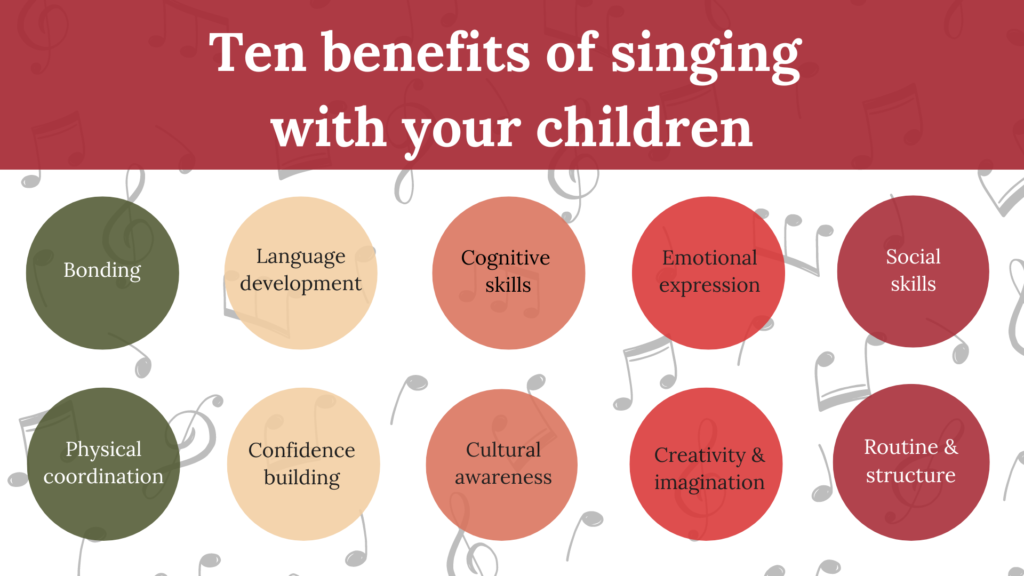
1. Bonding
Singing with your children creates a shared experience. Sharing experiences strengthen the emotional connection between you and your child. We do not need to constantly be taking our kids on some wild adventure. We can simply sing with them.
There was a study out of the University of Arizona that showed sharing musical experiences with your children, including singing, often leads to synchronized activities (like dancing together, playing instruments). This in turn causes you to like one another more by increasing the empathy you can feel towards each other. (Wow!)
Having a hard day with your toddler? Make sure to sing and dance with them!
Additionally, the Journal of Music Theory found that music has unique qualities which help support parent–child attachment/bonding in early childhood. Singing also has the ability to encourage emotional co-regulation and increase the interaction quality with your children. It can also enhance your parental sensitivity — your ability to perceive, interpret, and respond appropriately to your child’s cues and signals, particularly their emotional needs.

Feeling a little impatient and strung out with your children? Make sure to sing and dance with them!
But really! Do it!
2. Language Development
Songs often have repetitive patterns and rhymes that help children develop language skills, improve vocabulary, and understand sentence structure. So yes, sing “If You’re Happy and You Know It” a thousand times. It will pay off down the road…if you can keep your sanity in the process.
Repetition reinforces learning
Think about “Twinkle, Twinkle Little Star”. There are only 21 unique words in that song, but your child is really going to have a lot of practice with the word “star” and “twinkle”. This will enhance their word retention and their ability to recall those particular words.
Rhymes in songs increase phonemic awareness
Phonemic awareness is the ability to first recognize and then second manipulate individual sounds. An example is recognizing that “cat” and “bat” sound similar, but knowing that they are two different things. This may seem simple to you, but it is a skill your child has to learn.
This is a crucial step in phonics that helps in learning to reading. This foundation allows for effective decoding of words during reading and contributes to overall reading fluency and comprehension.
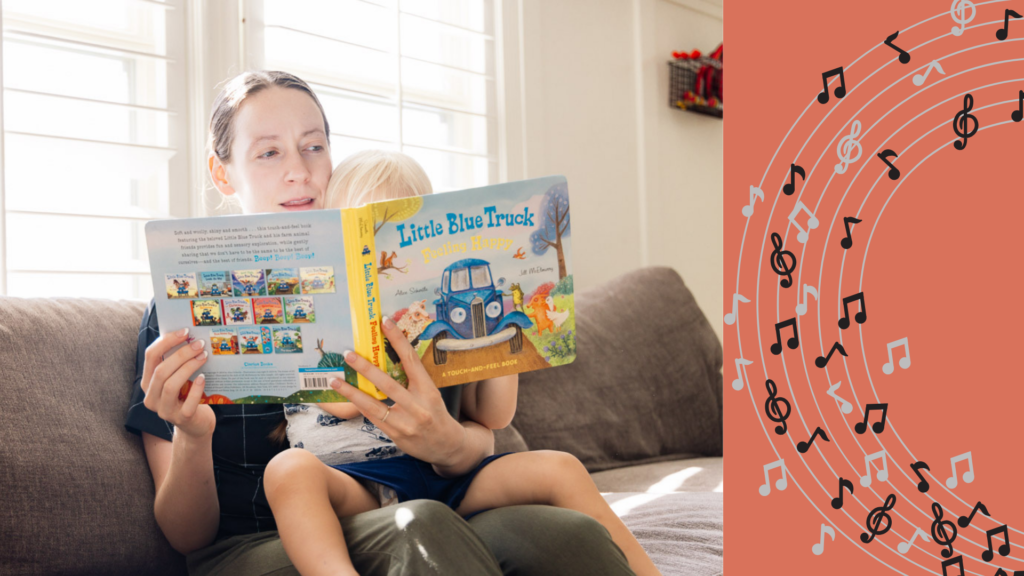
So next time you feeling a little silly while singing “Down by the Bay”, remember you are helping your kids develop their ability to read as they hear about a “bear combing his hair”.
Vocabulary expansion
Songs will introduce words to your child in a context that is easy for them to remember and understand. The combination of melody and rhythm makes the words in songs more memorable than in spoken language alone. For example, songs about animals, colors, or actions can significantly expand a child’s vocabulary related to those themes.
Both my children learned what “clapping” was from “If You’re Happy and You Know It!” They learned about “monkeys” from “Five Little Monkeys Jumping on the Bed”. If you feel your child’s vocabulary is not where it should be, start singing them new songs.
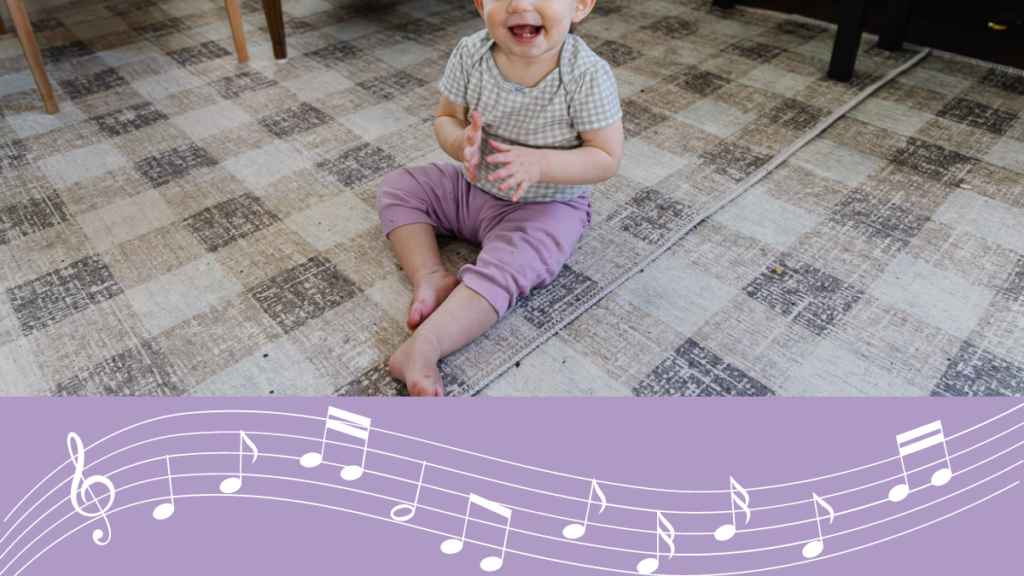
3. Cognitive skills
Learning lyrics and melodies stimulates memory and cognitive development. A study published in Frontiers in Neuroscience found that musically trained children performed better in memory tasks than their non-trained peers.
The study’s findings also suggests that the structured nature of musical activities, including singing and playing instruments, helps develop cognitive control regions in the brain, which are essential for sustaining attention and improving listening abilities.
Your little human might have some difficulty listening right now, but keep singing “Old MacDonald had a Farm”. Their listening skills are bound to improve!
4. Emotional expression
Music provides a safe space for children to express their emotions and understand different feelings. There are so many songs that are explicitly about emotions, but additionally, all songs can make us feel emotions.
Find songs that sound happy. Find songs that sound sad. Find songs that are calm. Find songs that are energizing. Sing a wide variety of songs with your children so they can experience a wide range of emotional feelings. You can take time to explain to your child that this is a happy song, a sad song, a wild song, or a calm song.
I sing “Hush, Little Baby” to my children when I need them to help them calm down. “Skip to My Lou” just does not have the same effect of calming my child down.
5. Social skills
Singing can easily be a group activity. You can sing with each child individually, with all your children at the same time, or even invite friends over for a singing time. Singing with others can improve turn-taking, cooperation, and empathy, as children learn to participate in a group activity. Learning to participate appropriately is a skill that I really focus on.
This is a difficult skill to develop, and depending on your child’s age, a skill that can take years of practice. An easy way to begin developing this skill through singing is by using the visual aids provided here to sing “Old MacDonald Had a Farm” with a group.
Give each child a different animal mask and when the group is singing about the “horse”, for example, have the child with the horse stand up. Have all the other children sit down during the other child’s turn. It will take some practice. Don’t get discouraged!
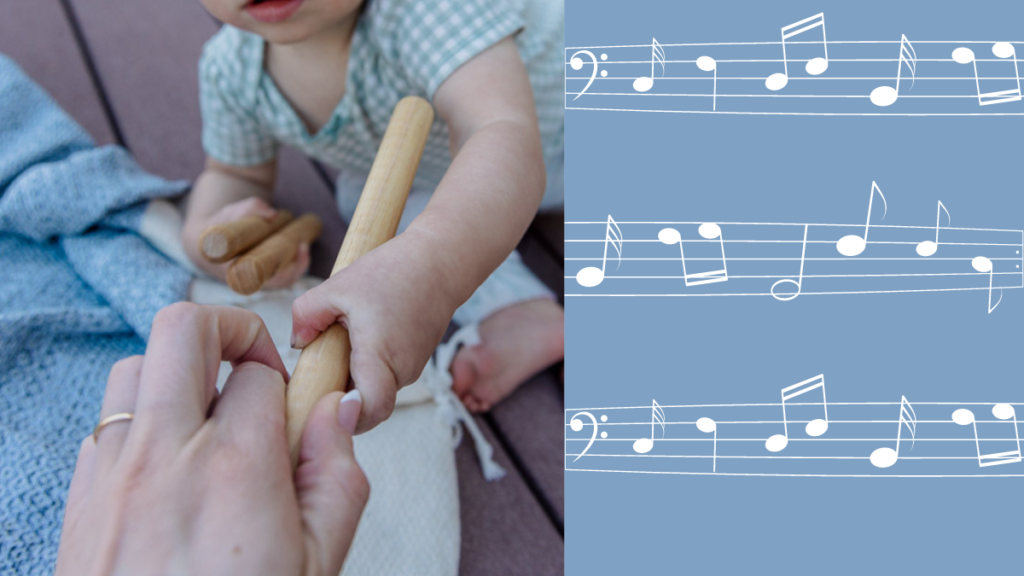
You can create songs that teach collaboration and cooperation by creating a song with a visual aid that is a puzzle. Each child will add the piece assigned to them when it is their turn. They will see how working together can make something complete.
Something you can do if you are singing with an older group of children, is playing songs with music note bells. This can teach them to work together to make a song.
6. Physical benefits
Singing often involves clapping, dancing, or other movements, which can improve motor skills and coordination. Singing can even help with breath control and posture of your child.
Motor skills
Coordinating singing with actions such as clapping, tapping, or dancing requires combining multiple motor functions. This combination of vocal and physical activity strengthens connections in the brain, particularly those involved in timing, coordination, and rhythm. For children, this can be especially beneficial as it helps develop fine and gross motor skills. This also improves hand-eye coordination and can help your child develop a sense of rhythm and timing.
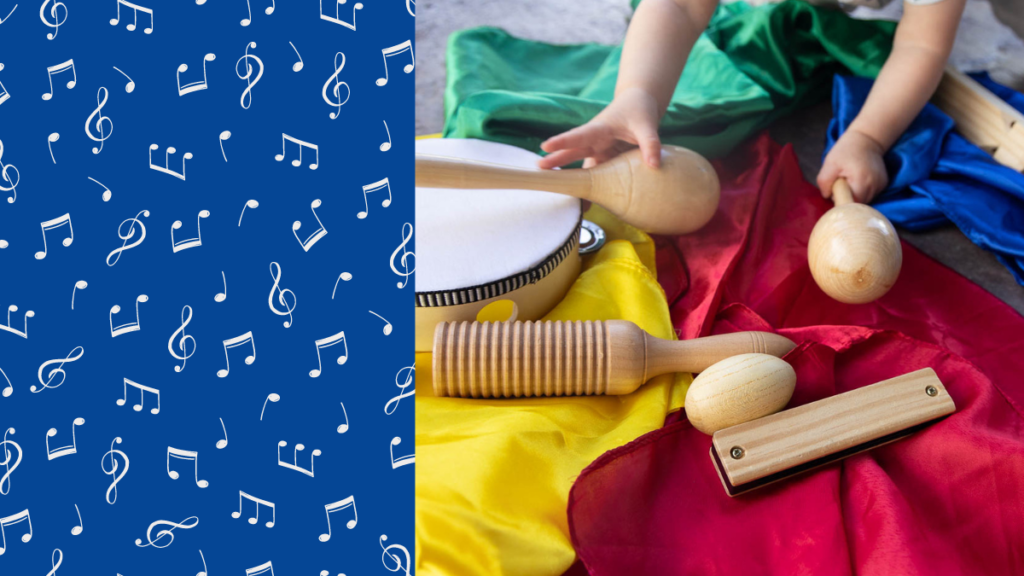
Having a sense of rhythm and timing is so important for developing other skills outside of singing. Skills like jumping rope, kicking a ball, and martial arts. Rhythm and timing is all around us.
Posture
To sing effectively requires good alignment of the shoulders, spine, and chest. Over time this good alignment can translate to everyday posture. It can reduce your child’s future back pain, neck pain, and improve their circulation and lung function.
Breath control
Singing requires managing airflow. It involves training many muscles involved in respiration. This control is essential not just for singing but also for speaking and other physical activities where breath management is crucial. Improved breath control can also contribute to better speech, reduced anxiety, and even enhanced endurance in physical activities.
7. Confidence building
Learning and improving skills is an important process for your child to participate in to build confidence. Regular singing can help build self-esteem and confidence in children as they learn to perform in front of others. This does not need to be fancy, big performances. This is them just singing to you/with you.
They also learn how to interact with their peers appropriately. (see above: #5 Social skills) This will give them the confidence to build friendships in other situations.
Singing gives them a chance to succeed again and again. They can also hear themselves improve their ability.
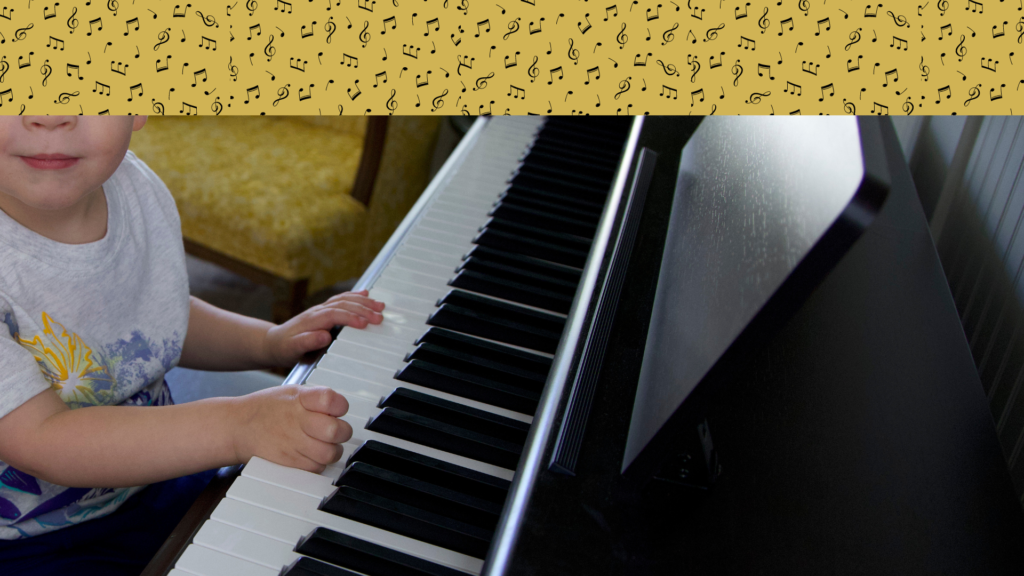
8. Cultural awareness
This can be a really fun and enriching one for you and your child. Singing songs from different cultures can expose children to diverse traditions, languages, and ideas, fostering inclusivity and global awareness.
My children love it when I sing “He’s Got the Whole World in His Hands”. This is a beautiful traditional African-American spiritual and has elements of this culture in the rhythm and lyrics of this song. It is unique from the other songs we usually sing. It creates some first exposure to diversity right in our home where it can be tricky to do so in other ways.
I also love to incorporate some songs in different languages or at least songs that have some words in a different language. “Feliz Navidad” is of course an easy one to whip out at Christmas time. One that I love is called “Children All Over the World”. It is about how children thank God while praying. It teaches how to say “thank you” in six different languages. It is so beautiful.
9. Creativity and imagination
Singing encourages creative thinking and the use of imagination as children create or adapt songs. Three of my brothers, who are now adults, are living proof that this is skill you can learn in childhood and use throughout your life. I have a brother that has a song he made up to the tune of “Indiana Jones” about his two sons. They love it when he sings it to them. Even I find it hysterical.
The first time I remember this happening growing up is when my brother was going through his intense dinosaur phase. You know that phase. Where your child seems to know everything about dinosaurs. He checked out a book from the library and made up a song describing each dinosaur found in that book. I can still sing that song to this day. I asked him about it a couple years ago. He definitely remembered the song, but he thought it was an actual song. It was that creative and catchy. (He is extremely musically inclined.) We did some intense searching on the internet, and he finally admitted it must be something he made up.

Keep your ears open for the cute and fun songs your children will begin to make up as you increase the singing in your home! It can get quite funny and give you a lot of insight into their interests and thought process.
10. Routine and structure
What mama doesn’t love a simple activity that helps move the day along and give it a little structure? Additionally, transitions can be so difficult for the developing minds of children. Singing can definitely help with some of those tough transition times.
My littlest was having a hard time falling asleep independently. We incorporated “Five Little Monkeys Jumping on the Bed” into her bedtime routine. She is still too little to understand what the story is talking about, but she still loves the routine. It cues to her that it is time to sleep. It has helped dramatically.
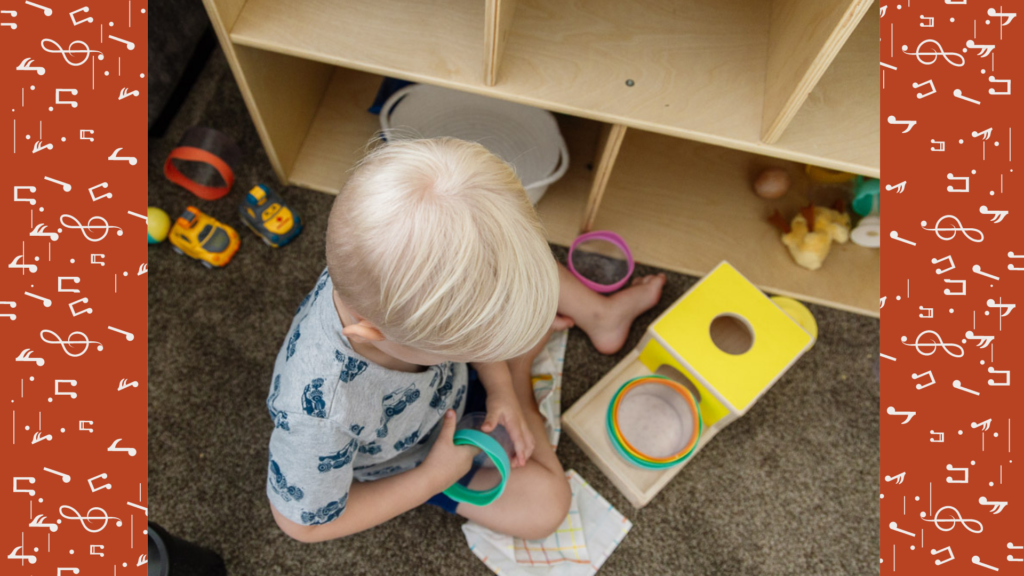
Another one of my children is very good at cleaning up when we start singing “clean-up, clean-up, everybody, everywhere”. It is almost a magic song in our house.
These are just some of the benefits that I have found in my house from singing with my children. Singing is an enjoyable activity that can lift spirits, reduce stress, and create a joyful atmosphere at home
Comment below some benefits that you may have seen in your home from singing with your children, or songs that you love to sing that have benefitted you littles! I am always looking for more ideas to add to our repertoire.
Be sure to share to encourage other mothers to sing with their littles!
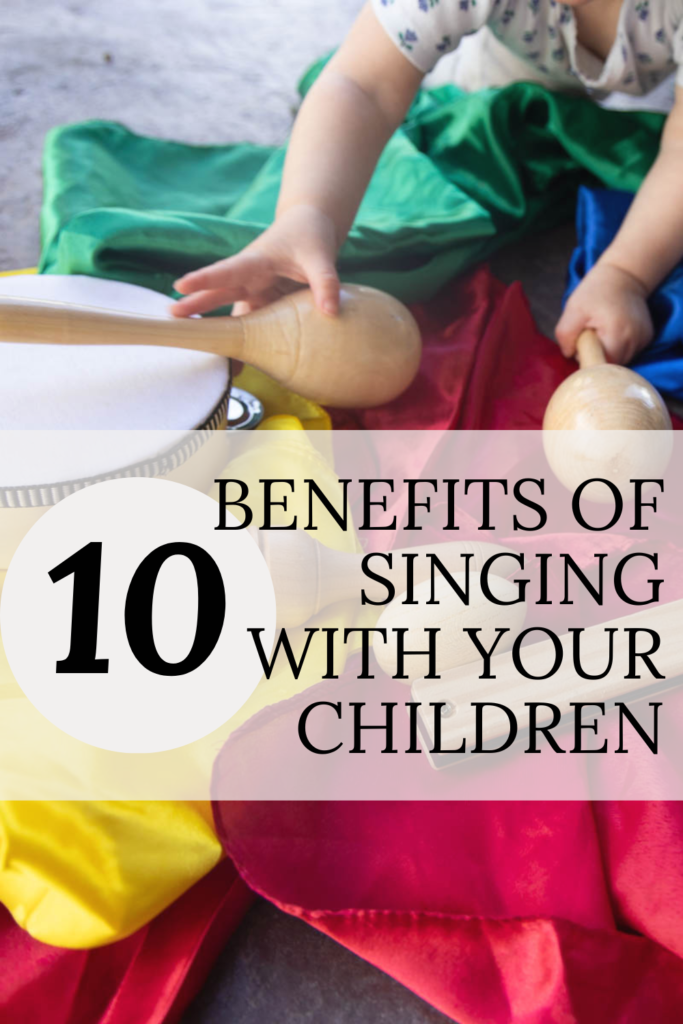
Check out our whole “Begin Singing with your Littles” series and grab your FREE ebook to get started:
FREE “Begin Singing with your Littles” ebook
Helpful tips to start singing with your children
The best ten sing-along books your child will love
5 easy scarf songs to sing with children
Fun and simple rhythm stick songs for kids
4 easy song with bells for toddlers | Add ringing to your singing
Action songs for toddlers | 15 great movement songs



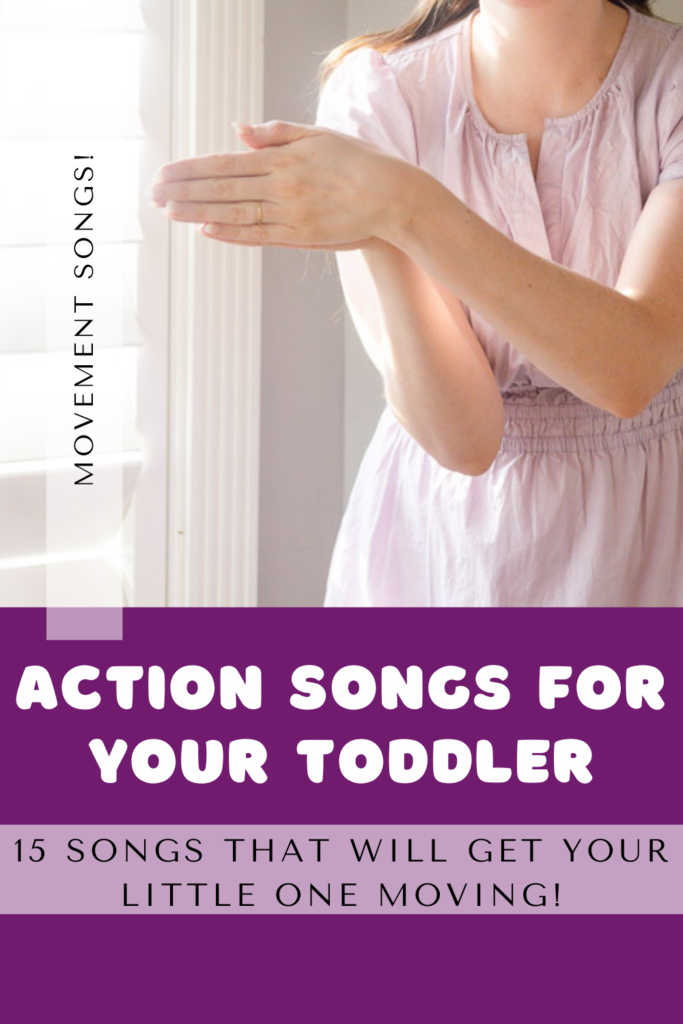
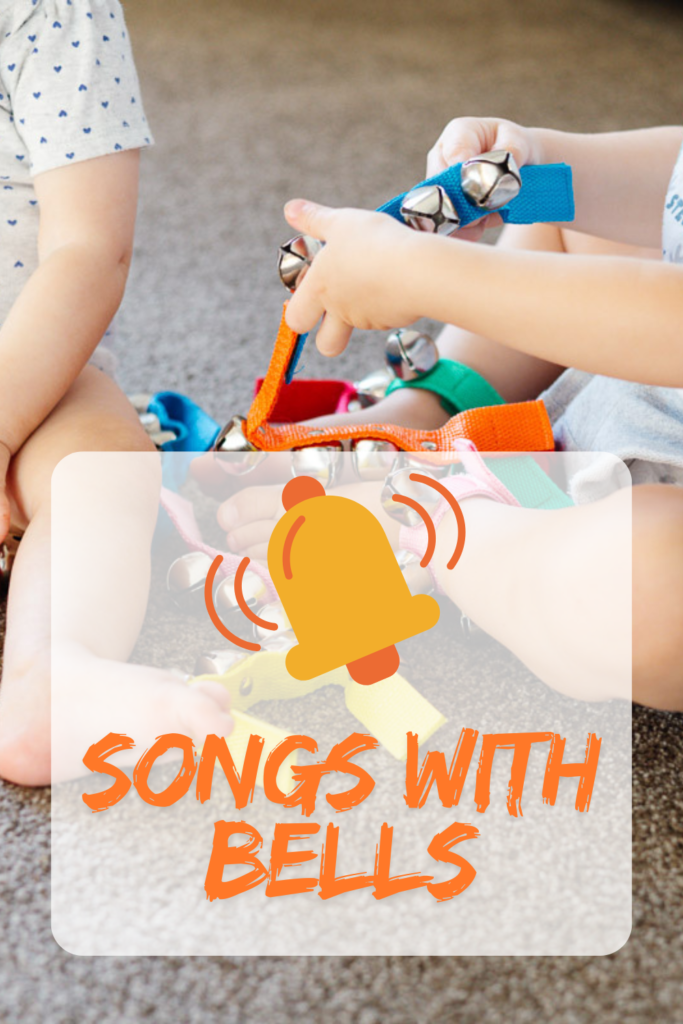
Leave a Comment